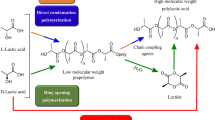Abstract
The analysis of data on the fabrication, structure, and properties of polylactide and polylactide fibres will allow drawing a conclusion concerning the promise of using them for production of high-quality textiles and articles for domestic, medical, sanitary-hygienic, and industrial applications. The existence of a renewable raw material base (plant stock), the use of biotechnology for fabrication of the monomer (lactic acid and its dilactide), and the simple technology for fabrication and melt spinning of the polymer show that production of these fibres will be economically feasible. Manufacture of these fibres does not involve complicated environmental problems due to the nontoxicity of the initial, intermediate, and finished products, and the possibility of recycling and biodegradation in the environment. As oil, coal, and gas deposits are being exhausted, polylactide fibres could become a promising large-tonnage variety of fibre. In this respect, it is necessary to develop comprehensive research to create optimum processes for production of lactic acid, polylactide, and polylactide fibres in Russia and to create industrial plants. With a wide spectrum of applications, polylactide fibres can be considered to be at the same level as other chemical fibres. They will not directly compete with existing chemical fibres, although they can be successfully used in place of or combined with them in many cases. At the same time, they have their own niche because of their specific properties.
Similar content being viewed by others
REFERENCES
K. E. Perepelkin, Khim. Volokna, No. 5, 3–16; No. 6, 3–13 (2000).
I. I. Shamolina, Khim. Volokna, No. 1, 3–10 (1997).
M. Matsui, Chem. Fibers Intern., 46,No. 6, 318–319 (1996).
Chem. Fibers Intern., 48,No. 2, 89 (1998); “Cargill Dow polymers: first commercial PLA plant for fibres,” Man-made Year Book. Chem. Fibers Intern., 6 (2000).
M. Dartee, J. Lunt, and A. Shafer, Chem. Fibers Intern., 50,No. 6, 546–551 (2000).
R. Hagen, “New process to reduce cost price of polylactide,” Man-made Year Book. Chem. Fibers Intern., 6–8 (2001).
M. Dartee, J. Lunt, and A. Shafer, “Naturworks PLA sustainable performance fibre,” Man-made Year Book. Chem. Fibers Intern., 29–31 (2001).
K. Yamanaka, Chem. Fibers Intern., 49,No. 6, 501–506 (1999).
N. S. Egorov (ed.), Industrial Microbiology [in Russian], Vysshaya Shkola, Moscow (1989).
L. M. Vorob'eva, Industrial Microbiology [in Russian], Izd. MGU, Moscow (1989).
N. P. Elinov, Principles of Microbiology [in Russian], Nauka, St. Petersburg (1995).
V. V. Korshak and S. V. Vinogradova, Heterochain Polyesters [in Russian], Izd. Akad. Nauk SSSR, Moscow (1958).
H. Mark and G. S. Whitby (eds.), Collected Papers of Wallace Hume Carothers on High Polymeric Substances, Interscience, New York (1940).
H. Klare, Geschichte der Chemiefasern, Akademie Verlag, Berlin (1985).
A. M. Bezborodov, “Fermentation,” in: Chemical Encyclopedia [in Russian], Vol. 3, Izd. BRE, Moscow (1988), pp. 608–611.
K. Yamanaka, in: Proceedings of the 38th Intern. Man-made Fibres Congress, Dornbirn, September 15–17, 1999, OECHI Publ., Vienna (1999), pp. 1–10.
J. Lunt, in: Proceedings and Abstracts of Posters, International Conference “Fibres and Textiles for the Future,” Tampere University of Technology, Tampere (August 16–17, 2001).
A. I. Dytnerskii, “Membrane separation,” in: Chemical Encyclopedia [in Russian], Vol. 3, Izd. BRE, Moscow (1992), pp. 38–45.
Yu. A. Treger, “Lactic acid,” in: Chemical Encyclopedia [in Russian], Vol. 3, Izd. BRE, Moscow (1992), pp. 130–131.
C. H. Holten, Lactic Acid. Properties and Chemistry/Lactic Acid and Derivatives, Weisheim (1971).
V. S. Livshits, “Polylactide,” in: Chemical Encyclopedia [in Russian], Vol. 2, Izd. BSE, Moscow (1974), p. 874.
A. K. Khomyakov, “Polylactide,” in: Chemical Encyclopedia [in Russian], Vol. 3, Izd. BRE, Moscow (1992), pp. 1262–1263.
“Glycolic acid,” in: Chemical Encyclopedia [in Russian], Vol. 1, Izd. BRE, Moscow (1988), pp. 1132–1133.
A. K. Khomyakov, “Polyglycolide,” in: Chemical Encyclopedia [in Russian], Vol. 3, Izd. BRE, Moscow (1992), pp. 1240–1241.
B. L. Biber and I. L. Kuz'mina, Khim. Volokna, No. 3, 53–57 (1991).
F. Fourne, Synthetic Fibers, Carl Henser Verlag, Munich-Vienna (1999).
N. L. Kuz'mina, B. L. Biber, et al., Problems in Production and Use of Surgical Sutures [in Russian], Ser. Prom. Khim. Volokon, NIITEKhim, Moscow (1989).
M. Dauner and H. Planck, in: Proceedings and Abstracts of Posters, International Conference “Fibres and Textiles for the Future, Tampere, August 16–17, 2001, Tampere University of Technology (2001), pp. 147–158.
V. V. Shevchenko, N. A. Plate, et al., in: Preprints of the International Symposium on Chemical Fibers [in Russian], Vol. %, Kalinin (1986), pp. 138–142.
R. Shishoo, in: Proceedings and Abstracts of Posters, International Conference “Fibres and Textiles for the Future, Tampere, August 16–17, 2001, Tampere University of Technology (2001), pp. 25–35.
K. E. Perepelkin, Structure and Properties of Fibres [in Russian], Khimiya, Moscow (1985).
K. E. Perepelkin, “Chemical fibres,” in: Chemical Encyclopedia [in Russian], Vol. 1, Izd. BRE, Moscow (1988), pp. 802–807.
K. E. Perepelkin, Khim. Volokna, No. 5, 8–19 (2001).
V. G. Lappo, T. V. Selavri, and E. I. Semenko, “Sanitary-hygienic characteristics of polymer materials,” in: Encyclopedia of Polymers [in Russian], Vol. 3, Izd. BSE, Moscow (1977), pp. 357–370.
N. I. Nikitin, Wood Chemistry [in Russian], Izd. Akad. Nauk SSSR, Moscow-Leningrad (1951).
B. S. Sapotnitskii, “The hydrolysis plant,” in: Chemical Encyclopedia [in Russian], Vol. 1, Izd. BRE, Moscow (1988), pp. 1100–1103.
A. I. Osadchaya, V. S. Polgorskii, et al., in: Biotechnological Utilization of Crop Wastes Podgorskii and V. N. Ivanov (eds.), Naukova Dumka, Kiev (1990).
V. I. Sharkov, S. A. Sapotninskii, et al., Hydrolysis Plant Technology [in Russian], Lesnaya Prom., Moscow (1973).
Author information
Authors and Affiliations
Rights and permissions
About this article
Cite this article
Perepelkin, K.E. Polylactide Fibres: Fabrication, Properties, Use, Prospects. A Review. Fibre Chemistry 34, 85–100 (2002). https://doi.org/10.1023/A:1016359925976
Issue Date:
DOI: https://doi.org/10.1023/A:1016359925976




